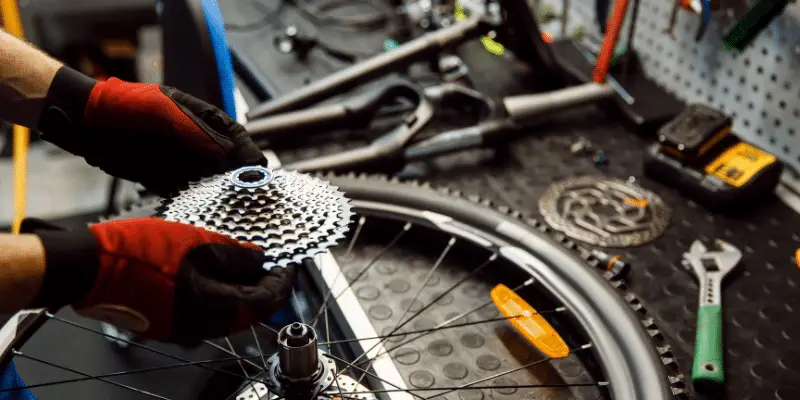In the intricate cycling world, the choice of components can significantly impact performance, comfort, and overall riding experience.
One such critical decision lies in selecting the bike’s cassette, which directly influences the range of gears available to the cyclist.
The “11-28” and “11-32” cassettes, indicated by the number of teeth on their smallest and largest cogs, respectively, are popular.
Each offers unique advantages and trade-offs, catering to different terrains and cycling preferences.
In this exploration, we will delve deep into the distinctions between the 11-28 and 11-32 cassettes, offering insights to help you determine the best fit for your riding needs.
Quick Navigation
11-28 Cassette
Range: This cassette has a range from a very small 11-tooth cog to a relatively large 28-tooth cog.
Advantages: Typically offers closer gear ratios, which means smoother transitions between gears. This might be preferred by road cyclists on flatter terrains where maintaining a steady cadence is crucial.
Disadvantages: Provides slightly less range than an 11-32, which means steeper climbs might require more effort, especially if you don’t have the right front chainrings to compensate.
11-32 Cassette
Range: This cassette stretches from an 11-tooth cog to an even larger 32-tooth cog.
Advantages: Offers a greater range of gears, making it better for varying terrain, especially steeper climbs. The larger 32-tooth cog can provide a more comfortable gear for uphill sections.
Disadvantages: The jumps between gears might be larger, so transitions might feel less smooth than an 11-28. This might not be the best option for flat terrains where you want to maintain a specific cadence.
11-28 vs 11-32 cassette

Here’s a comparison table for the “11-28” vs “11-32” cassette:
| Feature/Aspect | 11-28 Cassette | 11-32 Cassette |
|---|---|---|
| Gear Range | 11 teeth (smallest) to 28 teeth (largest) | 11 teeth (smallest) to 32 teeth (largest) |
| Best Suited Terrain | Flatter terrains and consistent speed. | Varied terrains, especially beneficial for steeper climbs. |
| Gear Transition | Smoother transitions with closer gear ratios. | Slightly larger jumps between gears which may be noticeable on consistent terrains. |
| Climbing Comfort | Good for moderate climbs, might require more effort on steep climbs. | Provides a comfortable gear for steeper uphill sections due to the larger 32-tooth cog. |
| Common Usage | Road racing, time trials, and criteriums on mostly flat terrains. | Adventure cycling, touring, gravel riding, or hilly road rides. |
| Cadence Maintenance | Easier to maintain a consistent cadence due to closer gear ratios. | Might require adjusting cadence more often due to the broader range. |
| Compatibility | Commonly found on standard road bikes. | Compatible with a variety of bikes, especially those designed for versatility over diverse terrains. |
This table provides a general overview, and individual preferences or specific bike setups might lead to different experiences.
Always consider the complete setup of your bike (like front chainrings) and your personal riding preferences when choosing a cassette.
Which one is better for you
Terrain: If you’re cycling in hilly or mountainous areas, the 11-32 might be more suitable due to its wider range. For flatter terrains, an 11-28 can be ideal.
Fitness: Stronger cyclists or those looking for a challenge might prefer an 11-28 even in hilly terrains, while those looking for more comfort might lean towards an 11-32.
Bike Type: While both cassettes can be found on various bike types, road bikes more commonly have 11-28 for flat terrains and race scenarios. Meanwhile, gravel, adventure bikes, or touring setups might lean more towards 11-32 for the versatility.
Front Chainring Setup: Your choice might also be influenced by whether you have a single, double, or triple chainring setup at the front. For instance, a bike with a compact chainring setup (like 50/34 teeth) paired with an 11-32 cassette can handle a wide range of terrains.
Lastly, it’s worth noting that there are many other cassette ranges available, and the best choice for you might be somewhere in between or even outside these two options. Consider your riding style, terrain, and needs when making a choice.
Conclusion
In cycling, the subtleties of gear selection can play a pivotal role in enhancing or impeding one’s ride. When juxtaposing the 11-28 cassette against the 11-32, the distinctions boil down to terrain preference, desired cadence, and overall riding objectives.
The 11-28 cassette, with its closely packed ratios, offers precision and consistency, making it a darling for racers and those frequenting flatter terrains.
On the other hand, with its extended range, the 11-32 cassette is a beacon of versatility, catering to those navigating varied landscapes or seeking added comfort on challenging climbs.
Ultimately, the best choice is not universally fixed but is tailored to an individual’s needs and the specific characteristics of their rides.
Whether you seek the rhythm of consistent cadence or the adaptability to conquer diverse terrains, understanding the nuances of these cassettes ensures an optimized cycling experience.
